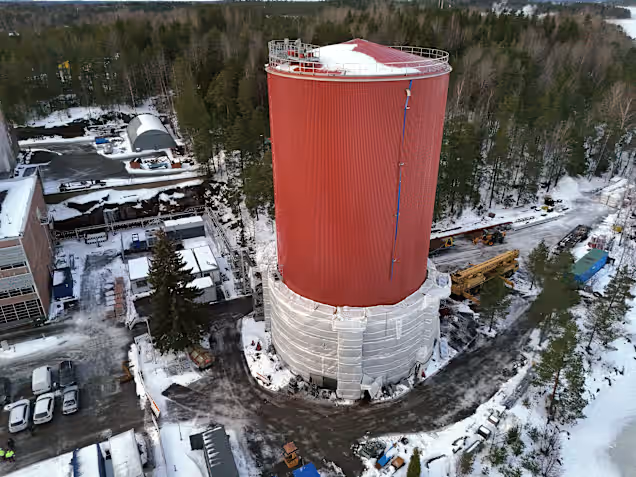Finland: Water towers booming, district heating with cheap electricity
Hot water storage facilities are being built because energy companies can benefit from very cheap electricity prices at certain times.
The increase in hot water storage facilities and thermal accumulators in Finland is strategically leveraging the availability of low-cost electricity, particularly during off-peak hours, to enhance the efficiency of district heating systems.
By storing excess heat generated during these times, companies can reduce operational costs and improve energy sustainability, ultimately contributing to more resilient heating infrastructures in the face of fluctuating energy prices and growing demand for renewable energy sources.
A record number of huge water towers are now being built in Finland – they will fill up as soon as the price of electricity collapses
The 10,000 cubic meter hot water storage facility at the Lappeenranta Energy power plant in Mertaniemi is set to begin operations early this summer, enhancing the plant’s capacity to manage energy supply and demand efficiently.
How the hot water storage becomes feasible
“We can heat water with electricity when electricity is cheap, store it, and release the storage into the district heating network when the price of electricity is more expensive,” explains Arto Nikkanen, CEO of Lappeenranta Energia
Adoption
According to the Finnish Energy Industries, around 30 different energy companies already have hot water storage tanks, or heat accumulators.
Janne Kerttula, Director of the Networks and Services Division of the Finnish Energy Industries, emphasizes that utilizing electricity-based district heating systems alongside hot water storage is well-suited for today’s electricity market, which experiences significant price volatility due to variable outputs from wind and solar energy sources.
The Finnish Energy Industries Federation’s report highlights that, during the previous year, the wholesale electricity market experienced significant negative pricing for 725 hours and zero pricing for 175 hours, indicating an abundance of cheap electricity. This surplus has made it economically feasible to utilize electricity for district heating, leveraging the low prices to enhance energy efficiency and reduce costs in heating systems.
 Profitable even when electricity prices are high
Profitable even when electricity prices are high
The Mertaniemi hot water storage facility in Lappeenranta, set to be operational by summer, is a significant investment of around five million euros, featuring a large, well-insulated steel tank that functions like a giant thermos bottle, capable of storing water at temperatures of up to 97 degrees.
The construction of the electric boiler in Mertaniemi in the 1980s was a response to the oil crisis, which led to a surge in oil prices, making electricity a more viable option for generating district heating at the time, providing a alternative solution to reliance on oil.
Arto Nikkanen, CEO of Lappeenranta Energia, indeed mentioned that their district heating system using molten salt and hot water storage allows for flexibility in pricing, enabling the company to generate revenue even on extremely cold days when electricity demand is high and prices are high.
This strategy allows the company to maximize its energy production efficiency by utilizing the excess heat generated from the Kaukas biopower plant, storing it for future use. By converting surplus district heat into stored energy, the company can not only meet demand fluctuations but also capitalize on favorable market prices for electricity, ultimately enhancing profitability and sustainability.
Motivation
According to Nikkanen, the hot water storage facility gives Lappeenranta Energy the opportunity to stem the pressure to increase district heating prices.
The annual savings are quite significant, several hundred thousand euros, says Nikkanen.
The price of district heating in Lappeenranta and more generally in Finland has been driven up in recent years by the sharp increase in the price of wood fuels in particular.
The biofuel market changed significantly with the war in Ukraine, when the Russian border was closed. The price of wood fuels has almost doubled in a couple of years, Nikkanen says.
This article is based on Kalle Schönberg’s article published at Yle. Teaser image Kare Lehtonen / Yle
Related
About the Author: CLIMATE STATE
POPULAR
COMMENTS
- Robert Schreib on Electricity generation prices may increase by as much as 50% if only based on coal and gas
- Robert Schreib on China made a historic commitment to reduce its emissions of greenhouse gases
- Lee Nikki on COP30: Climate Summit 2025 – Intro Climate Action Event
- Hollie Bailey on Leaders doubled down on fossil fuels after promising to reduce climate pollution
- Malcolm R Forster on Mythbusters tests global warming theory – does CO2 warm air?
This is a great idea! Using hot water storage to save energy and money is smart. I love that Finland is using cheap electricity to help the environment!